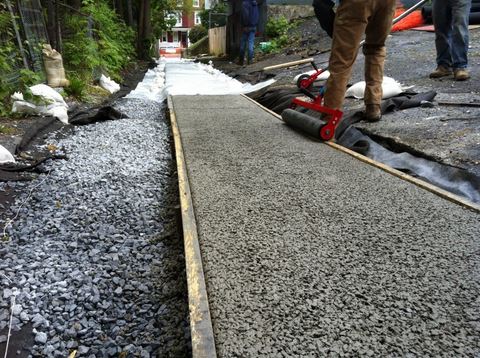
Plum Concrete: A Comprehensive Guide to Its Use in Construction
10 January 2025Table of Contents
Plum Concrete: A Comprehensive Guide to Its Use in Construction
Plum concrete is a specialized type of concrete widely used in construction for its cost-effectiveness and practical applications. By incorporating large stones (known as “plums”) into traditional concrete mixtures, this material reduces overall cement and aggregate requirements while maintaining structural integrity. In this article, we delve into the definition, applications, benefits, and construction methods of plum concrete, making it a valuable resource for engineers, architects, and builders.
What is Plum Concrete?
Plum concrete is a concrete mixture that includes large-sized stones or boulders (typically 150mm to 300mm in size) as filler material. These stones, known as “plums,” are embedded within a concrete matrix to reduce the use of cement and aggregates. Plum concrete is primarily used in areas where cost savings are critical or where load-bearing requirements are less stringent.
Composition of Plum Concrete
The primary ingredients of plum concrete are:
- Cement: Acts as the binding material.
- Fine Aggregate (Sand): Provides a smooth texture and fills voids.
- Coarse Aggregate: Standard-sized aggregates support the structural framework.
- Plum Stones: Large stones or boulders that occupy a significant volume of the mix.
- Water: Ensures proper hydration and workability of the mixture.
Applications of Plum Concrete
Plum concrete is ideal for a variety of construction projects due to its versatility and cost-effectiveness. Common applications include:
- Retaining Walls
- Used as a base or foundation layer to strengthen retaining walls.
- Mass Fillings
- Ideal for filling large voids, pits, or trenches where traditional concrete would be expensive.
- Slope Stabilization
- Helps stabilize slopes in hilly or mountainous regions by providing a sturdy base.
- Dams and Reservoirs
- Frequently used in the construction of gravity dams or as a secondary layer in reservoirs.
- Road Construction
- Suitable for sub-base layers in road construction, especially in rural or remote areas.
Benefits of Plum Concrete
1. Cost Efficiency
- By incorporating plums, the overall consumption of cement and aggregates is significantly reduced, resulting in lower costs.
2. Sustainability
- Utilizing locally available stones reduces the environmental impact of transporting materials and minimizes waste.
3. Strength and Durability
- While not suitable for high-load structures, plum concrete provides adequate strength for specific applications like retaining walls and mass fillings.
4. Easy Availability
- The use of locally sourced stones or boulders makes plum concrete accessible and practical, particularly in remote areas.
Construction Process for Plum Concrete
The process of constructing with plum concrete involves careful planning and execution to ensure structural stability. Here’s a step-by-step guide:
1. Site Preparation
- Clear the area of debris and level the surface where the plum concrete will be poured.
2. Placing the Plums
- Place large stones or boulders evenly within the designated area, ensuring they are clean and free of dirt or loose particles.
3. Mixing the Concrete
- Prepare the concrete mix using cement, sand, coarse aggregates, and water in the desired ratio (commonly 1:4:8 or 1:3:6).
4. Pouring the Concrete
- Pour the prepared concrete over the plums, ensuring it fills all gaps and voids between the stones.
5. Compaction
- Use manual or mechanical compaction tools to eliminate air pockets and achieve proper bonding between the concrete and plums.
6. Curing
- Allow the plum concrete to cure for at least 7-14 days by keeping it moist. Proper curing ensures strength and durability.
Limitations of Plum Concrete
While plum concrete offers numerous advantages, it also has certain limitations:
- Not Suitable for High-Load Structures
- Plum concrete is not recommended for structures requiring high compressive strength, such as bridges or multi-story buildings.
- Quality Control
- Ensuring uniform placement of plums and consistent concrete mix can be challenging, requiring skilled labor.
- Aesthetic Limitations
- The rough finish of plum concrete may not be suitable for projects requiring a polished appearance.
Conclusion
Plum concrete is a cost-effective and sustainable solution for specific construction needs, particularly in regions where materials are limited, and cost savings are essential. Its versatility makes it suitable for applications like retaining walls, mass fillings, and slope stabilization. However, proper planning, execution, and maintenance are crucial to ensure its effectiveness.


